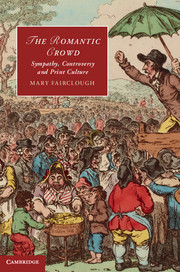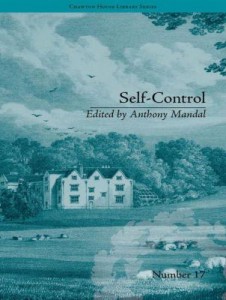Mary Fairclough is a Lecturer in English Literature in the Centre for Eighteenth Century Studies and the Department of English and Related Literature at the University of York, where she also completed her PhD; before rejoining York in 2012, she taught for four years at the University of Huddersfield. Her research explores the intersections between literary, political and scientific developments in the eighteenth and nineteenth centuries, focusing particularly on the ways that different disciplinary discourses employ, inform and complicate each other. In the interview below, we discuss her first monograph, The Romantic Crowd: Sympathy, Controversy and Print Culture, which was published by Cambridge University Press in January last year.
1) What brought you to realise that the crowd was a topic you wanted to consider at length?
I have Thomas De Quincey to blame for my interests in crowds – in the first term of my PhD research I was reading as much De Quincey as I could, and remember being struck by the peculiar way in which he described crowd behaviour: ‘Many a man has been drawn, by the contagion of sympathy with his own class acting as a mob, into outrages of destruction of spoliation, such as he could never have contemplated with toleration in his solitary hours.’ I kept returning to that quotation, and it eventually became the epigraph for my book. What interested me was De Quincey’s use of the term ‘sympathy’ as a means of accounting for collective behaviour. I had never encountered that use of sympathy before, and I wondered whether other writers of the period also used it when discussing crowds. As I read more widely in eighteenth- and early nineteenth-century literary and political writings I realised that other writers did indeed describe collective behaviour in terms of sympathy. And as I explored theories of collective behaviour I soon found that though no-one would still resort to a language of sympathy to account for the behaviour of crowds, commentators today have by no means come to a consensus about why, as De Quincey put it, people do things when in a crowd that they ‘could never have contemplated with toleration in [their] solitary hours.’ Romantic period writers’ use of a language of sympathy thus seemed a fascinating response to issues that we are still trying to come to terms with.
2) How did you approach the process of transforming your doctoral thesis into a monograph?
To be honest, my finished thesis felt to me like it was on the way to being a book, and my examiners encouraged me not to make drastic revisions before sending it to a publisher. So, slightly hubristically, I wrote up a proposal and sent off a very lightly revised manuscript, updated to take into account the most recent criticism, but with the same structure and focus as the thesis. The publisher’s anonymous readers made it clear I would need to rework my introduction and opening chapter, which I did, and then thankfully the book was accepted.
3) What do you see as being the defining characteristics of the Romantic crowd, as opposed to those figured in the earlier eighteenth century or the later nineteenth?
I argue in the book that it was only in the Romantic period that writers could use a language of sympathy to account for crowd behaviour, as a result of the coming together of a particular way of thinking about crowds and a particular way of thinking about sympathy. Earlier in the eighteenth century, commentators, particularly medical writers like Robert Whytt in Edinburgh, had diagnosed a ‘remarkable’ form of sympathy through which physical symptoms could be communicated from one person to another. But mid-century accounts of crowd action don’t use a language of contagious sympathy to describe collective behaviour. However, this understanding of contagious or collective sympathy survives until the end of the eighteenth and into the nineteenth century, and it’s after the French Revolution that commentators begin to use it to account for the actions of ‘mobs’, both in France and Britain. By the end of the Romantic period, though, this particular use of sympathy seems to die away – De Quincey is one of the last to use it. I argue that this can be accounted for by developments in physiology which meant that physical communication, whether individual or collective, was explained through theories of reflexes and nerves rather than this older, quasi-occult language of sympathy. So later nineteenth-century accounts of crowds, like that of Gustave Le Bon, use a medicalised language, but any reference to physiological sympathy has gone.
4) You contend in your introduction that in the Romantic period sympathy was generally ‘understood as a disruptive social phenomenon which functioned to spread disorder and unrest’, but detail in several of your chapters attempts by writers to reconfigure collective sympathy into a more positive formulation. What were the stakes in these writers’ interventions, and to what extent, in your view, did they succeed?
I argue in the book that the stakes were high in the effort to rehabilitate a language of collective sympathy in the Romantic period, which is demonstrated by the number of commentators in different fields who take on the challenge. I see these commentators as split along broadly ideological lines. Conservative writers generally have little interest in suggesting that collective action can be wholesome or beneficial, but radicals who are publicly committed to democratic reform need to find a way of describing collective action in positive terms. What I found fascinating is how few radical writers are able to ascribe a positive function to collective sympathy. Both William Godwin and Mary Wollstonecraft, for example, are unnerved by the apparently instinctive qualities of collective sympathy, or as Godwin terms it ‘brute and unintelligent sympathy’, which seems to bypass rational control. John Thelwall, in contrast, makes broadly positive (though not totally untroubled) claims for the wholesome basis of collective sympathy. I argue that he’s able to do so because his early medical training gives him an understanding of the way sympathy is said to regulate the functions of the body, and he applies that model by extension to collective bodies. But the only other writer in the book to make a straightforwardly positive claim for the value of collective sympathy is the moral philosopher Dugald Stewart. Like Thelwall, Stewart is well informed about the physiological operations of sympathy, but in addition he appears to take David Hume’s much older account of ethically sound sympathetic communication between individuals, and to make the case that this model can also be applied to crowds. But the fact that so few writers are able to rehabilitate collective sympathy shows, I think, the difficulty of the task.
5) What projects are you currently working on?
I’m working on a new book about the science of electricity in the long eighteenth century, focusing on the ways in which electricity, which was a totally new science at the period, seemed to elude attempts to theorise and categorise it. I argue that as a result, electricity was a highly mobile signifier, and extremely useful term for writers, who used metaphors of electricity to account for a whole range of unexplained and unprecedented cultural and social phenomena. I’m particularly interested in the ways in which metaphors involving electricity are evoked to describe acts of communication, either in person or in print. So I’ve moved some way from the concerns of my first book, but there is clearly also some important overlap, and I see the second project as informed by the first.




